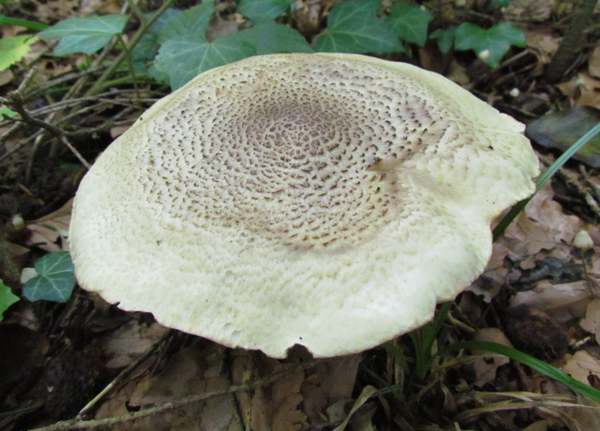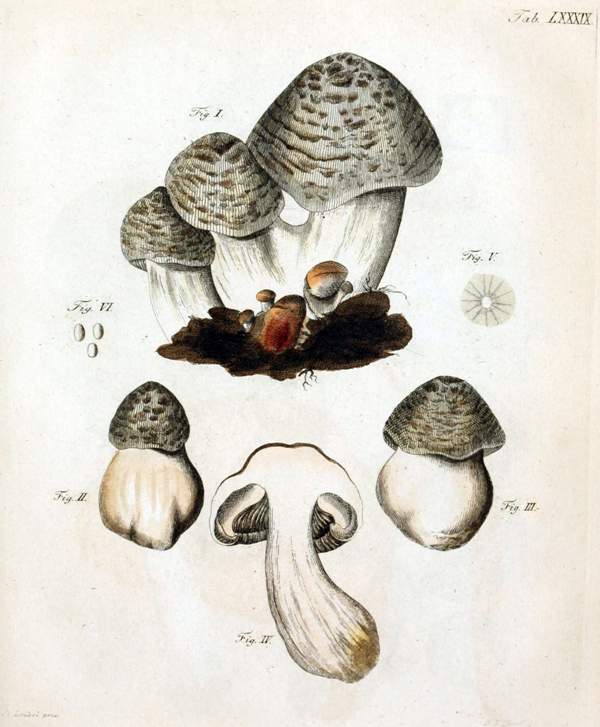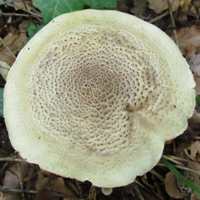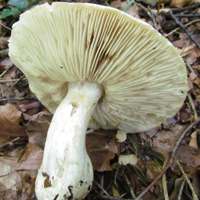Trees Birds Mammals Fish Amphibians Reptiles
Wild Algarve
Bookshop
Tricholoma pardinum Quél. - Leopard Knight
Phylum: Basidiomycota - Class: Agaricomycetes - Order: Agaricales - Family: Tricholomataceae
Distribution - Taxonomic History - Etymology - Identification - Culinary Notes - Reference Sources

Tricholoma pardinum is a striking mushroom and hard to miss, because it can grow to 15cm in diameter.
Unfortunately, however, Found under deciduous trees, notably birch (hence its common name Birch Knight), the caps expand with a low
central umbo, mature caps are radially streaky. It is generally considered a rather poor but edible mushroom.
In Britain there is no formally accepted common name for this 'knight', which from its appearance surely deserves the title Dirty Knight!
Distribution
This striking mycorrhizal mushroom is very rare in Britain with only one formally recorded sighting. It is a more common find in central and southern mainland Europe. Tricholoma pardinum is also recorded in some parts of North America.

Taxonomic history
There has been much debate over the authority for this species, and even after two centuries of arguing disagreement still springs up sporadically. Although this mushroom was described scientifically in 1801 by Christiaan Hendrik Persoon it is clear that others who recorded this species before him also have claims worthy of consideration. Jacob Christian Schaeffer was one such, as also was the Swiss mycologist Louis Gabriel Abraam Samuel Jean Secretan (1758 - 1839). Although Secretan was a lawyer he seems to have had little regard for the rules of botanical naming; as a result names that he allocated are generally invalid unless they have been subsequently republished by other authors.
The widely accepted scientific name Tricholoma pardinum dates from an 1873 publication by the French mycologist Lucien Quélet.
Synonyms of Tricholoma pardinum include Agaricus myomyces var. pardinus Pers., Gyrophila tigrina Schaeff. ex Quél., and Tricholoma pardalotum Herink & Kotl.
In his 1762 publication Fungorum qui in Bavaria et Palatinatu circa Ratisbonam nascuntur icones, nativis coloribus expressae, Jacob Christian Schaeffer included an illustration (above) of a mushroom that looks very much like Tricholoma pardinum, although his scientific description of the species was rather less clear. Schaeffer called this mushroom Agaricus tigrins (at a time when most gilled fungi were placed in the genus Agaricus, since largely redistributed across many new genera), which might therefore be considered as synonymous with Tricholoma pardinum; however, the specific epithet tigrinus is invalid because it has been allocated to Lentinus tigrinis, a gilled honorary member of the family Polyporaceae.
Etymology
Tricholoma was established as a genus by the great Swedish mycologist Elias Magnus Fries. The generic name comes from Greek words meaning 'hairy fringe', and it must be one of the least appropriate mycological genus names, because very few species within this genus have hairy or even shaggily scaly cap margins that would justify the descriptive term.
The specific epithet pardinum comes from the Latin 'pardus' meaning leopard; it is a reference to the spotted nature of the cap of this mushroom. (It's interesting that Schaeffer saw it as striped like a tiger rather than spotted like a leopard!)
Identification guide
 |
Cap
Initially hemispherical and then flattening out with a broad low umbo; a whitish background patterned with concentric rings of dark brownish or grey scales that appear as elongated spots, larger towards the centre and smaller and less prominent towards the rim; 5 to 15cm across. |

|
Gills
Initially white but turning yellowish, sometimes with a green tinge, the gills are free of the stem.
Stem
White or pale grey-brown; often fibrillose; 3-8cm long, 1.5-2cm in diameter with a base swollen to typically twice the upper stem diameter; no stem ring. |
| |
Spores
Ellipsoidal, smooth, 7.5-9.5 x 5-7μm with a pronounced attachment peg (known as a hilar appendage); hyaline; inamyloid.
Spore print
White. |
Odour/taste |
Not usually significant, but forms with a mealy odour and a cucumber-like taste are known. |
Habitat & Ecological role |
Ectomycorrhizal with deciduous trees, mainly birches, usually in wet places; occasionally on roadside verges under hedgerows. |
Season |
Late summer and autumn. |
Similar species |
Tricholoma equestre has a brown-yellow cap but is distinguished by its bright-yellow gills. |
Culinary Notes
Generally regarded as inedible, which is no bad thing in view of its rarity in many countries.
Reference Sources
Fascinated by Fungi, 2nd Edition, Pat O'Reilly 2016, reprinted by Coch-y-bonddu Books in 2022.
Kibby, G (2013) The Genus Tricholoma in Britain, published by Geoffrey Kibby
Dictionary of the Fungi; Paul M. Kirk, Paul F. Cannon, David W. Minter and J. A. Stalpers; CABI, 2008.
Taxonomic history and synonym information on these pages is drawn from many sources but in particular from the British Mycological Society's GB Checklist of Fungi.
Top of page...
Fascinated by Fungi. Back by popular demand, Pat O'Reilly's best-selling 450-page hardback book is available now. The latest second edition was republished with a sparkling new cover design in September 2022 by Coch-y-Bonddu Books. Full details and copies are available from the publisher's online bookshop...